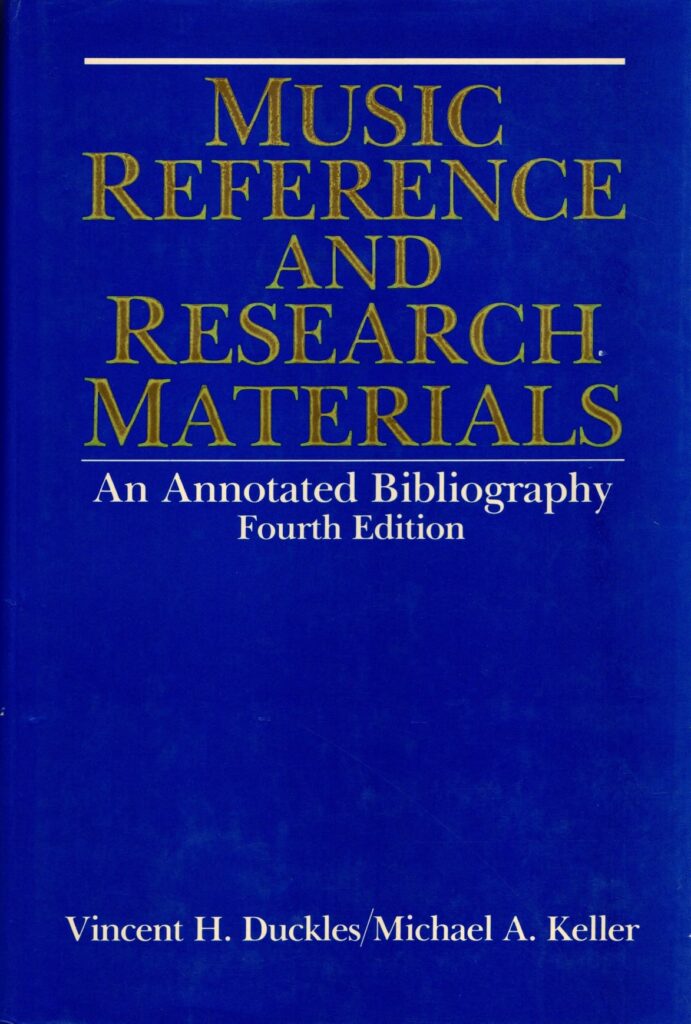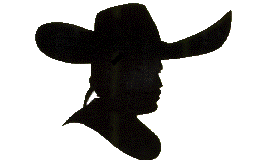Introduction:
Reference services in academic libraries have evolved significantly since the mid-1980s. In 1985-86, when I attended Library School at the University of Arizona, I took several courses in reference service, including basic reference, information sources in the humanities, and administration of reference.
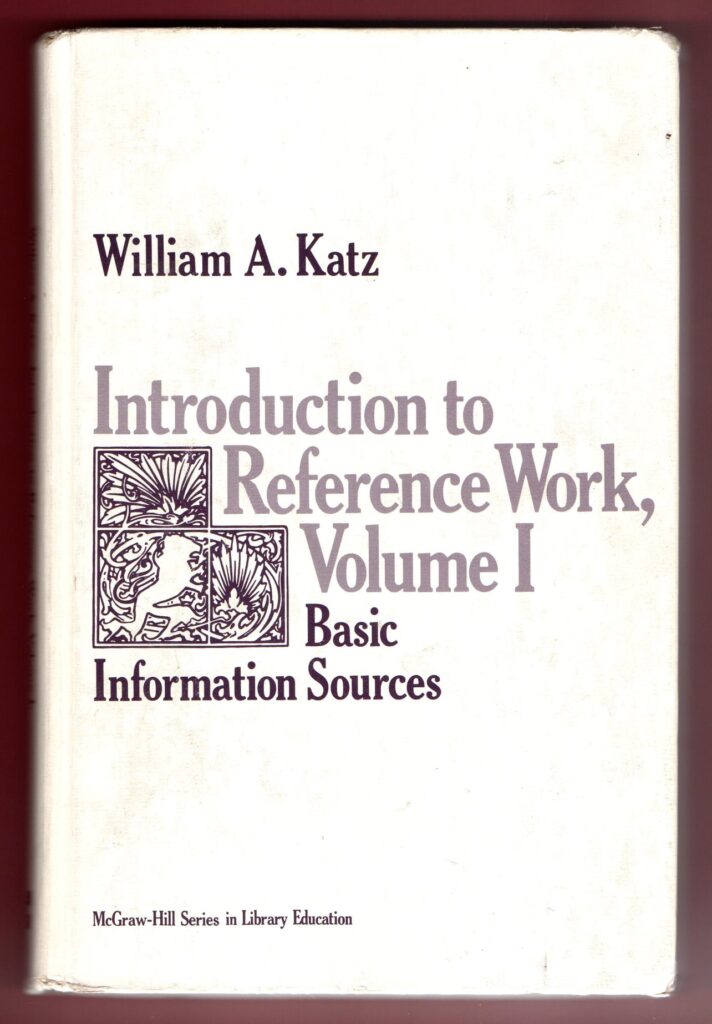
I also completed a six month internship at the UA LIbrary reference desk.
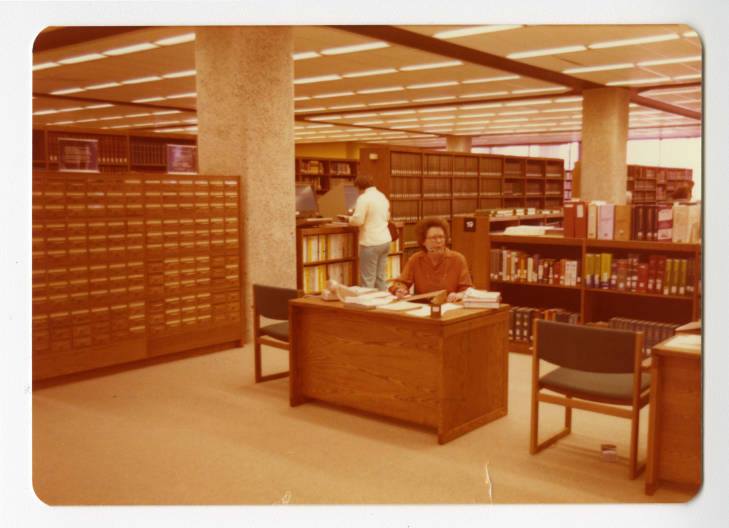
Librarians back then did not have computers or the Internet to rely upon for finding information or finding facts. Instead, they used, among other paper-based tools, dictionaries, encyclopedias, almanacs, chronologies, directories, indexes, bibliographies and of course, the card catalog.
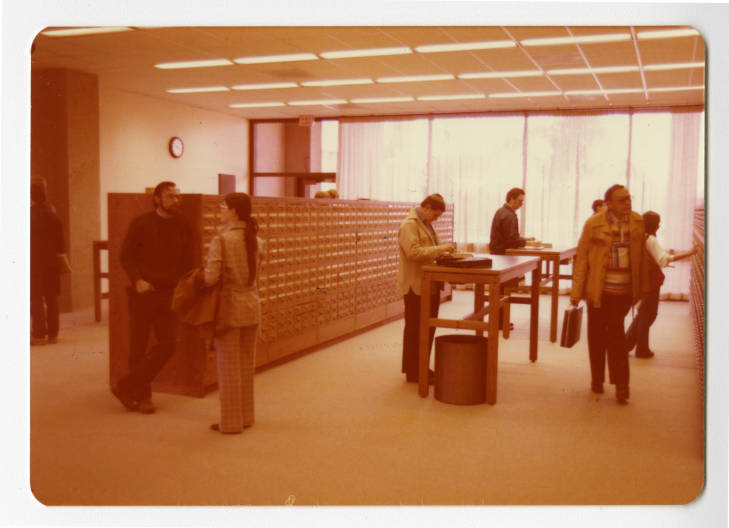
In 1987, after spending seven months working as a children’s librarian at the Nogales-Santa Cruz County Public Library, (my first job after library school), I was hired at the University of Michigan and worked in the Undergraduate Library as a reference and instruction librarian for five and a half years. I worked the desk an average of 12 hours a week and spent many, many hours providing classroom-based library instruction. From 1990 to 1992, I managed the reference assistant program, hiring and training graduate students in the art of reference service.
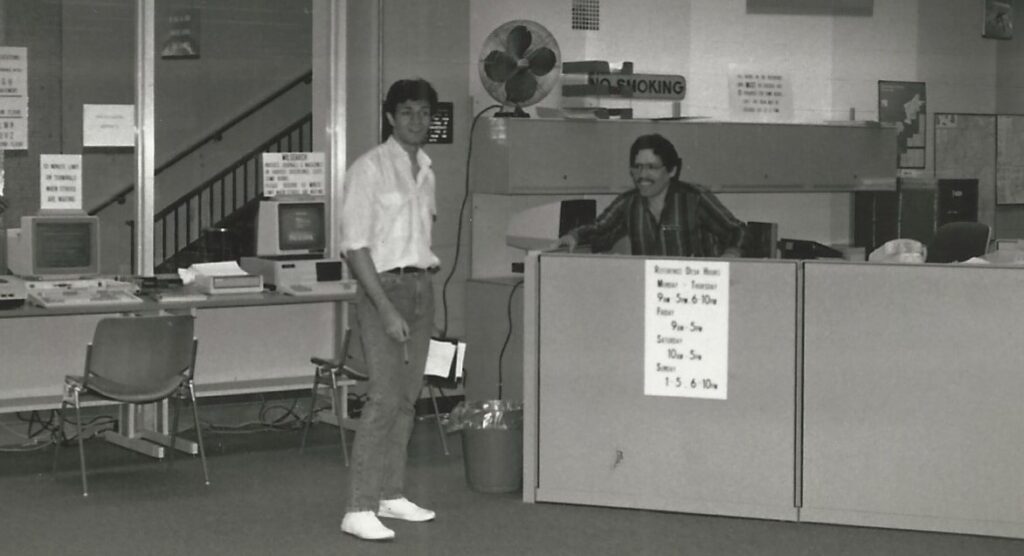

In 1992, I was hired at the University of Arizona Library as the Assistant to the Dean for staff development, recruitment, and diversity. My reference skills proved to be invaluable in my new job, as I considered myself an expert user of the library, and I could easily use indexes, the library catalog and other reference tools to find information related to my new job. I served as the Assistant to the Dean for 8 years.
During that 8 year-period, computers were starting to transform the way libraries provided access to information. Online catalogs made keyword searching possible, and over time more and more reference tools were available in computerized formats. However, it took a long time for computers to completely make paper-based reference tools a thing of the past. Librarians who provided reference service in specific subject areas continued to rely on what are known as “research guides” to do their work. Here are a few examples:
In 2000, I decided to shift gears and I joined the Fine Arts and Humanities team at the UA LIbrary, and my new areas of focus (with some changes over time), were music, dance, media arts, theater arts and Africana Studies. My office was in the Fine Arts Library, and my duties included reference, faculty liaison work, library instruction and collection development. I created subject research guides and spent a great deal of time adding diverse materials to the music collection, which while strongly focused on Western Art Music, held very little material on world music, jazz, Latin American music or popular music. I also did library instruction for students in theater arts, music, dance, media arts and, later, Africana studies.
By the early 2000’s, the World Wide Web had gained a strong foothold across the globe, and more and more resources were becoming available electronically. Wikipedia became the all-in-one, go to reference source for many people, especially students, and many libraries began changing how they provided reference services. Some began hiring paraprofessionals to staff their reference and information desks or eliminated reference desks altogether, and librarians who specialized in reference, were encouraged to develop new skills in other areas such as assessment, grantsmanship, and knowledge management.
Below is a sampling of the kinds of training I did and the research guides I created while a public services librarian at the Fine Arts Library:
Basic Music Reference Sources / 2005. This is the outline to a training session I created for staff at the University of Arizona Fine Arts Library. It was designed to give a basic orientation to the topic.
Country Music Reference Resources / 2005. This is comprehensive resource guide to country music that I put together in 2005 when I worked at the Fine Arts Library. It has not been updated since then. It includes some websites (likely outdated by now), but consists mostly of books, the majority of which are available at the University of Arizona’s Fine Arts Library.
Resources for the Study of Early/Modern Music. / 2006. This is a research guide I prepared for a class in the Group for Early/Modern Studies program at the University of Arizona in 2006.
Congressional Universe Training session / Workshop, April 29, 2010. I conducted this research database workshop as a member of the Library’s Research Services Support Connection Development Team. The database covers a variety of governmental and congressional resources.
Latin Music Resources / Web page, March 27, 2011. A page I created when I was the music, dance and theater arts librarian in 2011. The links no longer work, as the page is inactive, but there are still useful resources included.
The Flute: A Resource Guide / Web page, June 10, 2011. I created this web page as a resource for flute students and members of the National Flute Association when I was working out of the Fine Arts Library. The web page is no longer available, and the links in many cases do not work, but much of the information is still relevant and useful.
Mexican American Studies: A Guide to Resources / Research Guide, December , 2011. (Note: the links included in this guide no longer work, as our catalog records were all migrated to a different system a few years ago. One can still use our current catalog, however, to search for the titles included in this guide.)
I worked as a member of the Fine Arts Humanities Team (which later became Team Y, and then Research Support Services) until 2011. At that point, the Dean of the Library offered me a position in Special Collections to manage the department’s exhibits and events program and to focus on building collections in the performing arts, with an emphasis on the Southwest.
As a member of Special Collections, I curated exhibitions for the Main Library, the Science Engineering Library and Special Collections from 2012 to 2018. In addition to serving as curator for the performing arts, over time I also took on management of the department’s architectural collections. Since 2019, I have managed our virtual reference services. Learning new areas and new skills came easily to me, as I continued to rely on my research skills to come up to speed on subjects and issues that I had not previously worked on.
So here we are. I was asked to do a session for you on how we do reference in Special Collections. I thought I would add some background for you, so that you have an idea of the work I’ve done in the area of reference, and so that you get a sense of how computers and the internet have, over time changed the work that librarians do.
Special Collections librarians and archivists provide access to rare, unique, and one-of-a-kind materials and material housed in archival or manuscript collections. Reference service within the context of a special collections library or archives, is really no different from the traditional reference that librarians have provided over time. While more and more material is becoming available digitally, most of the resources found in special collections and archival repositories requires physical access, human intervention and the use of fact tools and finding tools.

Public services in our department have changed a great deal over the past 20 years. At one point, archivists and librarians staffed the front desk, and individuals seeking access to our materials worked with specialists in the department to gain access to our archival holdings. Finding aids/collection guides were not available electronically. The librarians and archivists on staff needed to build their expertise and knowledge of our collections over time. (Arizona Archives Online, which provides access to the finding aids for materials in Special Collections, was established over 20 years ago, and was one of the first such tools available for accessing archival materials. Our department was part of this effort from the beginning, but it took many years to get all of our finding aids loaded into the system).
Approximately 10 years ago, the Library administration decided to have members of the library’s access and information services team (some had library degrees but all were paraprofessionals) manage our front desk, which they did until the end of 2019. They relied upon the Special Collections archivists and librarians to provide in-depth consultations for patrons whose needs were not readily identifiable. The AIS staff also managed our electronic reference service, and also passed on to the specialists on the staff those questions that required more in-depth subject expertise.
In 2019, the administration made yet another change, and pulled AIS staff out of Special Collections, putting the front desk operations back in the hands of Special Collections staff. This required shifting some job duties and making room in everyone’s schedules for spending time at the desk. It also required that Special Collections staff take on management of the virtual reference tools that had been used primarily by AIS staff. We had to re-learn how to use the library’s circulation system, which was new to most of us, (we switched from a company called Innovative Interfaces, Inc. to ExLibris/Alma just a couple of years ago), and we had to learn how to use Libanswers, a module in a product called Libapps, produced by a company called Springshare.

In March 2020, just three months after Special Collections staff took over management of the front desk, the pandemic hit, and we were closed down, but still did our best to provide reference services and access to our collections. We publicized on our website that we were closed, but encouraged users to use our Services page to request research assistance and digital copies of materials, which we later started providing when possible.
In July 2020, I worked with Patricia Ballesteros, a staff member in the department, to develop a set of guidelines for the provision of reference and reading room services for users of Special Collections. It was revised a couple of times since then. The document is titled, “Recommendations for Reference/Research Consultation and Reading Room Services.“
I currently manage our Libanswers system, and twice a day I check the “queue” to see which questions have come through. These questions are either requests for appointments to view our collections, requests for subject assistance, requests for digital copies of material or permissions requests. My job is to handle those questions that I feel I can adequately answer, to handle copyright and permissions requests, and to route to the staff those questions that require their expertise. Our duplications process is handled by Patricia Ballesteros. She also manages the appointments process and the reading room operation. Because we provide service by appointment only, we are better able to prepare for our patrons’ visits, and we have their materials ready for them to view when they arrive. We allow only three people in the reading room at a time at present and provide services Monday through Friday from 10 to noon and 2 to 4pm.
Staff also receive questions directly via email or telephone. Another job I have is to gather monthly statistics on our reference service. The LibApps product contains a module called Libinsight that we use to report our statistics. We gather information on our user population, what materials they use and how frequently we respond to questions.
I recently conducted a brief training session for Special Collections staff on statistics gathering. It was in the form of a powerpoint presentation To view it, click on the following title: “Keeping our statistics up to date”.
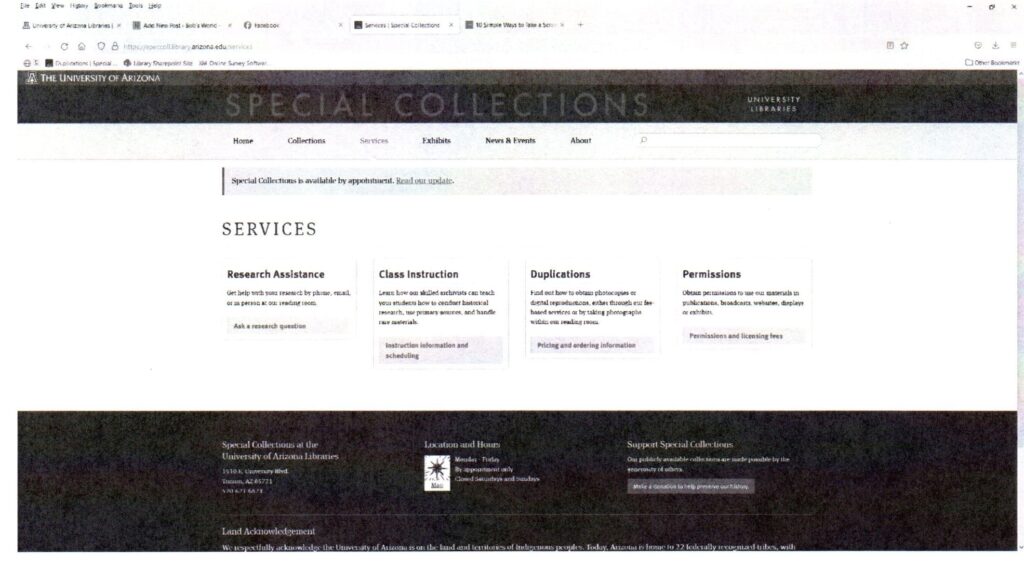
Each year, we answer approximately 1,000 questions. You can see what our areas of focus are by going to the Special Collections page and clicking on the words “explore our collections“.
The reference interview is a very important part of the process of helping people find what they’re looking for. Sometimes, they won’t be direct about what they need, so it’s important to probe a little by asking clarifying questions. Patron’s sometimes are nervous or afraid to reveal too much information. You should tread lightly if the patron shows any signs of hesitation. Our patrons have privacy rights, and its important to treat the consultation process professionally and to keep information confidential, especially if it is in any way sensitive or if the patron requests confidentiality. Sometimes the patron doesn’t really know what they are looking for, so the job of the specialist is to help guide them in determining what resources might be useful to them. Because at present we are not providing walk in service, we encourage our users to use our online tools to figure out what they want. We also refer users to our specialists for additional assistance.
We sometimes get customers who want us to do all their research for them. At times, we do accommodate such requests, particularly if the person making the request is a major donor. Most of the time, however, we let our customers know that we can usually spend only up to 30 minutes to an hour doing research for them. As was just noted, we encourage our users to learn how to find information on their own by pointing them to a variety of tools, such as our online catalog, our Special Collections page, our indexes page, Arizona Archives online or any number of other sources available to them.
Here is a list of specialists in Special Collections:
Roger Myers: rare books, photography, artists books and anything having to do with the history of Special Collections
Veronica Reyes-Escudero: Borderlands Studies, the Southwest.
Bob Diaz: performing arts (theater, vaudeville, dance, music, film), architecture.
Erika Castano: University of Arizona History, digital formats.
Steve Hussman: political affairs, history of science, medicine, mining.
Trent Purdy: audio/visual formats, curator for the USS Arizona collection.
Amanda Howard: audio/visual formats.
Randi Johnson: digital formats.
Lisa Duncan: general questions about our archives.
While local history falls under the category of “borderlands studies”, there are others on the staff with knowledge about Tucson and Arizona history, including Erika Castano, Bob Diaz, and Roger Myers.
We tend to get lots of questions about UA history, architecture, specifically the Joesler collection, Arizona history, mining, vaudeville, local history and genealogical questions.
There are a lot of tools that we use to help our patrons. Some are fact tools, such as directories and almanacs, others are finding tools such as indexes and catalogs. Below are links to various sections of the library website, to research guides and other resources that are important to know about when working in Special Collections.
Helpful Resources:
About Special Collections page: This information page tells the reader what the University of Arizona Library’s Special Collections department’s areas of strength are: (Arizona and the Southwest, U.S-Mexico Borderlands, Literature, Political Affairs, Performing Arts, History of Science and University of Arizona History. Links are also provided to other information, including FAQ’s, hours, location and parking, contact information etc.
Architectural Collections at the University of Arizona Libraries : This page provides an overview of the architecture-related collections held in Special Collections, and provides background information about the various architects represented in our collections
ArchiveGrid . From the home page: “ArchiveGrid includes over 7 million records describing archival materials, bringing together information about historical documents, personal papers, family histories, and more. With over 1,400 archival institutions represented, ArchiveGrid helps researchers looking for primary source materials held in archives, libraries, museums and historical societies”.
Arizona, Southwestern and Borderlands Photograph Collection. Housed in Special Collections at the University of Arizona, this collection contains photographs, from various sources, of Arizona, New Mexico and Mexico including places, people, events and activities, and dating from about 1875 to the present. Formats include postcards, stereographs, cabinet cards, cyanotypes, viewbooks and photoprints.
Arizona and Southwestern Biographical File. The University of Arizona Library, Special Collections. Contains biographical sketches, clippings, articles, and miscellaneous documentation of various people from the late 1800’s to the present. Files vary in size and content and do not include photographs.
Arizona Archives Online . Arizona Archives Online (AAO) provides free public access to descriptions of archival collections, preserved and made accessible by Arizona repositories, including libraries, special collections, archives, historical societies, and museums. Use this source for finding archival collections housed in the UA Library’s Special Collections department.
Arizona genealogical and historical research guide : early sources for southern Arizona : including Cochise, Pima, Pinal, and Santa Cruz counties (Special Collections, F810 S26 2006). A guide for genealogical and historical research on southern Arizona that includes resources from a wide variety of organizations, and advice on finding records from cemeteries, the military, immigration documents, newspapers, medical records, schools, and more.
Arizona Historical Society Library. “The Arizona Historical Society Libraries & Archives collects published and unpublished material of enduring historical value that allows researchers to explore Arizona’s economic, political, social, and cultural heritage. Formats include manuscripts, photographs, diaries, letters, oral histories, sound recordings, moving images, microfilm, maps, books, and digital files”.
Arizona History (research guide) This guide, compiled by University of Arizona librarian Mary Feeney, provides a select list of basic reference sources on Arizona, as well as a list of indexes and primary research resources useful for conducting more in-depth research in Arizona history and other related topics. Includes information on access to Arizona newspaper.
Arizona Memory Project. The Arizona Memory Project provides access to the wealth of digitally available primary sources in Arizona archives, museums, libraries, and other cultural institutions. Visitors to the site will find some of the best examples of government documents, photographs, maps, and multimedia that chronicle Arizona’s past and present.
Arizona News (research guide): This list of resources is a subset of a guide to materials by type from the University of Arizona Library’s website, and provides links to five different collections of historical newspapers from Arizona. Included are links to Mexican American newspapers, local Tucson newspapers, as well as newspapers from other cities in Arizona.
Arizona, Southwestern and Miscellaneous Vertical File
Finding materials by type (research guide)
Finding primary sources (research guide)
Historical news sources (research guide)
History (comprised of several regional history guides
Index to Arizona News in the Arizona Daily Star. Special Collections AI 21 .A72
Jack Shaeffer Photographic Collection
Joesler Digital Collection (still considered a hidden collection because it has no access point in our catalog yet).
News sources (research guide)
Proquest Dissertations and Theses Global
Records of the Catholic Church, Diocese of Tucson.
Special Collections research guides
Tucson City Directories: Special Collections D9791 T89
University of Arizona Biographical File
University of Arizona Catalogs digital collection
University of Arizona Libraries website, including catalog
University of Arizona Photograph Collection
University of Arizona Theses and Dissertations (Campus Repository)
University of Arizona Yearbooks digital collection
Hidden collections: These are collections housed within Special Collections that do not have any access tools attached to them.
*University of Arizona Life and Times
*University of Arizona Annual Reports from Colleges and Schools, Depts. Etc. through the early 1980s.
*University of Arizona performing arts programs of musical performances, plays, and dance recitals given by students and faculty in the Schools of Music, Dance and Theater Arts.
*The backlog
A word about genealogical research: We have tended to shy away from answering genealogy-related questions, although we do have some collections that provide access to people’s names and family histories. These include the records of the Catholic Diocese of Tucson, and the Alianza Hispanoamericana Records collection, among others. Genealogy research is time consuming, and there are other places locally where people can get expert advice. The Arizona Historical Society Library offers genealogy reference and the Church of Latter Day Saints has a local Family History Center. There is also a local organization called the Southern Arizona Genealogical Society that offers low cost memberships to people interested in genealogy.
Learn where materials are located. There are several sections of materials. The manuscript collection includes collections in the AZ call number range and the MS call number range. Our book collection uses three different classification systems, the Dewey Decimal system, Library of Congress and the Arizona Collection classification system, which was developed in house many years ago. We also have oversized materials, elephant oversized materials, maps in flat files, pamphlet collections, oversized photo and oversized vertical file collections.
A word about copyright: It’s important to know some basics about copyright law and the permissions process. A great tool for learning about it is housed at Cornell University Library. It’s called the Cornell Copyright Center. Copyright law is always changing, so it’s important to keep up with such changes when possible.
The ability to answer reference questions and research queries is a skill that is developed over time. You won’t know or learn everything all at once, and it’s important to ask for help when you need it. The Special Collections staff often works collaboratively to help our customers with questions that are difficult or time consuming.
I encourage you to learn the basic tools: our catalogs, our indexes, our finding aids and collection guides. Explore, do your own research on topics of interest to you and ask lots of questions. Reference service can be very fulfilling. It helps to have a strong desire to continuously learn new things and to explore a variety of topics.
Sources consulted and other useful titles:
American Reference Books Annual, . Santa Barbara: Libraries Unlimited (Main Library stacks and reference , Z1035.1 .B5344)
Art Information Research Methods and Sources, by Lois Swan Jones. Dubuque, IA: Kendall/Hunt Publishing. 1990. (Science Library N85. J64 1990)
Developing and Maintaining Practical Archives, by Gregory S. Hunter. New York; Neal-Schuman, 2003. CD 950 .H86 2003. (New 2020 edition available electronically via Ebscohost)
Guide to Reference: Essential General Reference and Library Science Sources, Chicago: American Library Association, 2014.
Guide to Reference Books, compiled by Eugene P. Sheehy. Chicago: American Library Association, 1976. (Latest edition published in 1996 and authored by Balay and Carrington. Main Library, Z1035.1 .G89 1996)
The Humanities: A Selective Guide to Information Sources, by Ron Blazek and Elizabeth Aversa, Englewood, CO.: LIbraries Unlimited, 1994, 2000. Main Library Z6265 .B53 2000 AZ 221 .
Introduction to Reference Work Volume I: Basic Information Sources, by William A. Katz. New York: McGraw-Hill, 1982. (2002 edition available at Main Library Z711 .K32 2002)
Introduction to Reference Work, Volume II: Reference Services and Reference Processes, by William A. Katz. New York: McGraw-Hill, 1978.
Introduction to Reference Work in the Digital Age, by Joseph Janes. (Main Library Z711 .J36 2003)
Literary Research Guide: A Guide to Reference Sources for the Study of Literatures in English and Related Topics, by James L. Harner. New York: Modern Languages Association of America, 1989. ( 1993 edition available at Main Library, PR83 .H373 1993)
Managing Reference Today: New Models and Best Practices, by Kay Ann Cassell. London: Rowman and Littlefield, 2017. Main Library Z711 C354 2017
Music Reference and Research Materials: An Annotated Bibliography, by Vincent H. Duckles and Michael A. Keller. New York: Schirmer, 1988. (1997 edition available at Fine Arts Library, ML 113 .D83 1997)
Providing Reference Services for Archives and Manuscripts, by Mary Jo Pugh. Chicago: Society of American Archivists, 2005. (Main Library CD971 .P84 2005)
Reference and Information Services: An Introduction, by Richard E. Bopp and Linda C. Smith. Englewood, CO.: Libraries Unlimited, 2001. (2011 edition available at Main Library, Z711. R443 2001)
Tucson: A Drama in Time, by John Warnock. Tucson: Wheatmark, 2019. (Bob Diaz private collection).
Tucson: The Old Pueblo–A chronology, Tucson Pima County Historical Commission. Special Collections F 819 .T957 T83 1977

